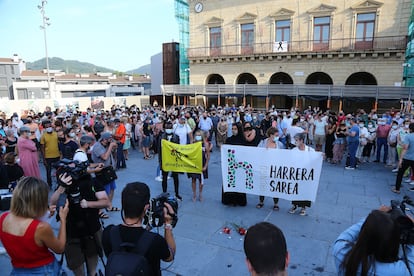Spain’s Bidasoa river: the new ‘death trap’ for migrants
A growing number of people are attempting to swim the crossing to reach France, despite the numerous dangers involved

Jon is one of the people in charge of Irungo Harrera Sarea, an NGO flagging up the fact that more and more migrants are swimming across the Bidasoa river in Spain’s Basque Country along the 10 kilometers where it borders France: “If neither the Atlantic nor the Mediterranean has deterred them, how is the river in Irun going to stop them? And it is a terrible mistake,” he says.
So far this year, 4,100 migrants have crossed the border illegally, most of them on foot; others by car or bus and a growing number are swimming across the river, according to data from the Basque regional government. And that is not counting those who have stayed in Red Cross shelters and those who distrust any official organizations. Fifty migrants remain in the Basque city of Irun waiting to cross to France, with the river always there as an option.
The Bidasoa river has already claimed two lives this year. On Sunday, a man drowned while trying to cross to the other side. And another, Yaya, a 28-year-old from the Ivory Coast, died in May. The month before, a third had taken his own life by throwing himself into the river.
If 4,244 migrants resorted to the Basque government’s aid in 2019, 4,100 have already done so in just the first eight months of 2021. In 2020, the year the coronavirus pandemic hit Spain, the Basque government registered 3,493 migrants. “This past Friday, 80 people heading north used the Basque government’s resources in the Irun area; on Saturday, 60; and on Sunday, 20 remained,” says Xabier Legarreta, the director of the Basque government’s Migration and Asylum department. He stresses that what is playing out is a “humanitarian drama.”

Legarreta says that “safe humanitarian corridors” should be created: the European Union “has to take action on the matter,” he explains. The Irun NGO, Irungo Harrera Sarea, estimates that an average of 20 to 30 migrants arrive in the city every day on their way north. “Ninety-five percent of them come from the Canary Islands,” Jon explains: “Once on the mainland, they manage to make their way up to Irun en route to northern Europe.”
But when they arrive in Irun, they find that the border is closed off. The official explanation from the French side is the pandemic. There are controls for pedestrians, train passengers and even for those in small boats. “And they are not general controls, they are selective; they only ask for the documentation of those who look Arabic or sub-Saharan African,” says Jon.
If their documentation is not in order, they are sent back to Spain. Up to two or three times in many cases, without any involvement from the Spanish police. They are left on the Santiago or Behobia bridges. “Desperation is starting to wreak havoc among the most unlucky migrants,” says Jon. “And in that state of desperation, they do whatever it takes to continue their journey.”
Ten kilometers “impossible to control 24 hours a day”
The river is not, however, a viable option. Although the Basque police keep an eye on the banks of the Bidasoa as it passes through Irun, the 10 kilometers that make up the border are “impossible to control 24 hours a day,” says one police officer, though he does add that surveillance is increasingly intense.
“It is not unusual to see four or five crossing in a group,” says Jon. “The problem,” he explains, is that the word is spreading among the migrant community that crossing the Bidasoa river is easy because in some places there are barely 40 or 50 meters between the two banks and at low tide, it gives the impression one could walk across.
“The river is an illusion,” says Adrián, from the Santiagotarrak Sports Society in Irún, which specializes in rowing and canoeing and whose members know the Bidasoa like the back of their hand. “The other shore seems very close, but it’s actually very far away, and if they are tired or malnourished or don’t know how to swim very well, it’s a death trap at some points.”
Spanish canoeist and Olympic medalist Maialen Chourraut used to train at the so-called San Miguel curve, about three kilometers from Pheasant Island where the migrant died on Sunday. It is an area of rapids stretching about 150 meters that, when the tide is high, is used by whitewater rafting specialists. At low tide, you have to be careful because of the abundance of tide pools.
Yaya, the migrant who died in May, lost his life in the Pheasant Island area, in the part closest to France, where the river becomes deep. On that stretch, the depth changes abruptly. Traveling with his nephew, who survived, Yaya worked as a bricklayer and taxi driver in order for them both to travel to Europe. The pair got a boat in Western Sahara and after five days adrift they reached the Canary Islands. They then traveled to Málaga and from there to Irun. But Yaya did not make it past the Bidasoa river. “People are dying because they are not given a passage,” says Anaitze Agirre, another spokeswoman for the Irungo Harrera Sarea NGO.
The French authorities’ strict border controls in Irun are also favoring those preying on the migrants’ desperation, according to Jon. Between those who claim to organize a safe passage to the other side and leave them on the shore, and those who charge €50 to get them through only to let them down, “a business is being generated that is beginning to get dangerous,” he says.
One migrant protesting Sunday’s fatality was Hakim. The drowned man has not yet been identified. All that is known from his footprints is that he was not registered. On the back of the tragedy, Hakim says he has decided he will not swim to France. Though he says this in a mumble. Because, if there is only that option, if the other routes are closed.... who knows?
English version by Heather Galloway.
Tu suscripción se está usando en otro dispositivo
¿Quieres añadir otro usuario a tu suscripción?
Si continúas leyendo en este dispositivo, no se podrá leer en el otro.
FlechaTu suscripción se está usando en otro dispositivo y solo puedes acceder a EL PAÍS desde un dispositivo a la vez.
Si quieres compartir tu cuenta, cambia tu suscripción a la modalidad Premium, así podrás añadir otro usuario. Cada uno accederá con su propia cuenta de email, lo que os permitirá personalizar vuestra experiencia en EL PAÍS.
¿Tienes una suscripción de empresa? Accede aquí para contratar más cuentas.
En el caso de no saber quién está usando tu cuenta, te recomendamos cambiar tu contraseña aquí.
Si decides continuar compartiendo tu cuenta, este mensaje se mostrará en tu dispositivo y en el de la otra persona que está usando tu cuenta de forma indefinida, afectando a tu experiencia de lectura. Puedes consultar aquí los términos y condiciones de la suscripción digital.
Últimas noticias
From digital curfews to blocking apps: How technology experts protect their children online
Why the price of coffee has skyrocketed: from Brazilian plantations to specialty coffee houses
Confined to a Cuban hospital: When electricity is a matter of life or death
The complicated life of Francesca Albanese: A rising figure in Italy but barred from every bank by Trump’s sanctions
Most viewed
- Why we lost the habit of sleeping in two segments and how that changed our sense of time
- Pablo Escobar’s hippos: A serious environmental problem, 40 years on
- Trump’s obsession with putting his name on everything is unprecedented in the United States
- The Florida Keys tourist paradise is besieged by immigration agents: ‘We’ve never seen anything like this’
- Charles Dubouloz, mountaineering star, retires at 36 with a farewell tour inspired by Walter Bonatti









































